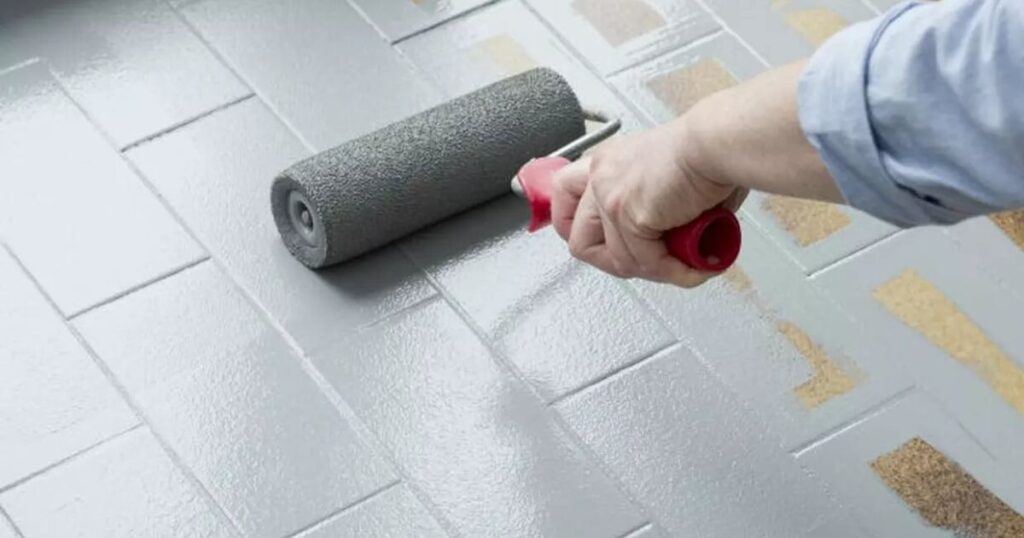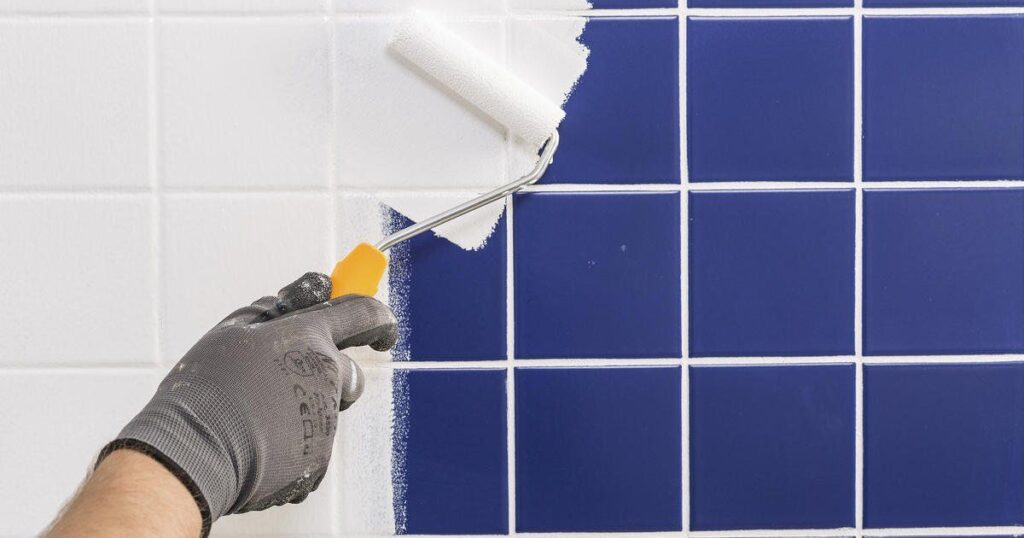Can Bathroom Tile Be Painted?
Many homeowners need help with the dilemma of outdated bathroom tiles but hesitate to undergo the expense and hassle of a complete renovation. However, painting the tiles is a surprising solution that can breathe new life into your bathroom without breaking the bank. But before you grab a brush, you might wonder, can you paint bathroom tiles?
The answer is a resounding yes. You can indeed paint bathroom tiles, including floor tiles, to refresh the look of your space. This process offers a budget-friendly alternative to costly tile replacement, allowing you to achieve a fresh and updated appearance without needing extensive remodeling.
Special Considerations
Before diving into a tile painting project, it’s essential to consider several factors to ensure successful results. One of the primary considerations is the type of tile you have in your bathroom. While many tile materials can be painted, some may require special treatment or may not be suitable for painting.
For example, ceramic, natural stone, and unglazed quarry tile are popular options that can be easily painted. However, glazed quarry tile presents a challenge, as paint may need help to adhere to its slick surface.
Additionally, it’s essential to recognize that painting bathroom tiles is more than a one-and-done task. Proper preparation is vital to achieving long-lasting results, which may involve sanding, cleaning, and repairing the tiled surface before applying paint. Moreover, choosing the right paint color and finish can significantly impact the outcome of your project, so take the time to select options that complement your bathroom’s aesthetic.
Pros of Painting Tile

Painting bathroom tiles offers several advantages, making it an attractive option for homeowners seeking to update their bathrooms. Here are some of the key benefits:
- Cost-Effectiveness: Painting tile is far more affordable than replacing it entirely. While the material costs of new tiles can add up quickly, painting offers a budget-friendly alternative that can save you hundreds or even thousands of dollars.
- Customization: With paint, the possibilities are virtually endless. You can choose from various colors and finishes, allowing you to customize your bathroom to suit your style and preferences.
- Flexibility: Unlike traditional tiles, which are permanent fixtures, painted tiles offer flexibility and versatility. If you ever tire of your chosen color or want to update your bathroom’s look, you can repaint the tiles to achieve a fresh new appearance.
Cons of Painting Tile
While painting bathroom tiles offers numerous benefits, it’s also essential to consider the potential drawbacks. Here are some of the cons to keep in mind:
- Maintenance: Painted tiles may require periodic maintenance, especially in high-moisture areas such as showers and tub surrounds. Over time, the paint may wear or peel, necessitating touch-ups or repainting.
- Limited Texture Options: Unlike traditional tiles, which come in various textures and finishes, painted tiles are limited in texture. While you can achieve a smooth or glossy finish with paint, replicating the texture of natural stone or ceramic tiles may be challenging.
- Durability: While properly applied paint can provide a durable finish, it may not be as durable as traditional tile materials. Painted tiles may be more prone to scratches, chips, and other damage, especially in high-traffic areas.
Painting Over Tiling That’s Already Painted
If your bathroom tiles have already been painted, you may wonder whether it’s possible to paint over them again. The good news is that most painted tiles can be repainted, allowing you to update your bathroom’s look as desired.
However, it’s important to note that repainting over-painted tiles may require additional preparation and maintenance. Over time, the existing paint may wear or peel, necessitating thorough cleaning, sanding, and repainting to ensure a smooth and durable finish.
Paint Types To Use With Bathroom Tile
When painting bathroom tiles, selecting the correct type of paint is crucial to achieving optimal results. Here are some paint types that are suitable for use with various tile materials:
- Latex Paint: Suitable for ceramic, porcelain, and unglazed quarry tile, latex paint is a popular choice due to its ease of use and low odor. However, it may not be as durable as other options and require additional sealing for high-moisture areas.
- Epoxy Paint: Ideal for areas prone to moisture and heavy wear, epoxy paint offers superior durability and resistance to water, heat, and everyday wear and tear. It’s particularly well-suited for tub surrounds, backsplashes, and shower surfaces.
- Acrylic Latex Paint: Recommended for natural stone tiles, acrylic latex paint provides a durable and moisture-resistant finish. However, it’s important to note that glossier finishes may increase slipperiness, so consider opting for a matte or satin finish.
Materials Needed
Before embarking on a tile painting project, gather the following materials to ensure you have everything you need for a successful outcome:
- Cleaning Supplies: Dish soap, vinegar, sponges, and scrubbing brushes for thoroughly cleaning the tiled surface.
- Sandpaper: Various grit sandpapers rough the surface and promote paint adhesion.
- Painter’s Tape: To protect adjacent surfaces from accidental paint splatters.
- Drop Cloths: Protect the bathroom floor and fixtures from paint drips and spills.
- Paint Primer: This is for better paint adhesion and durability.
- Paint Brushes and Rollers: These apply primer and paint to the tiled surface.
- Clear Sealer: Optional for providing additional protection in high-moisture areas.
Tools Needed
In addition to materials, you’ll also need the following tools to prepare and paint your bathroom tiles:
- Putty Knife: For repairing cracks, chips, and other damage on the tiled surface.
- Caulking Gun: This is used to apply caulk to seal gaps and cracks in the tile grout.
- Foam Roller: This is used to achieve a smooth and even finish on textured tiles.
- Paint Tray: For pouring and holding paint during the painting process.
Preparing the Tiled Surface
Preparing the surface properly before painting your bathroom tiles is essential to ensure optimal adhesion and durability. Follow these steps to prepare the tiled surface for painting:
Step 1: Sand
Using fine-grit sandpaper, lightly sand the surface of the tiles to roughen them up and promote paint adhesion. Be sure to sand all areas of the tile, including the face, grout, and any buildup or stains.
Step 2: Repair Any Damage
Inspect the tiled surface for cracks, chips, or other damage, and repair them as needed before painting. Use caulk to fill small cracks, while larger cracks may require a putty knife and waterproof spackle for more extensive repairs.
Step 3: Clean and Decide Strategy
Thoroughly clean the tiled surface with soap and water to remove dirt, grime, and residues. Once cleaned, assess
whether you want to paint over the grout lines or each tile individually, as this will impact your painting strategy and technique.
How to Paint Bathroom Tile
It’s time to begin painting with the tiled surface adequately prepared. Follow these steps for the best results:
Step 1: Prime
Apply a coat of primer to the tiled surface using a paintbrush or roller, ensuring even coverage over all areas of the tile. Choose a primer suitable for your tile material and allow it to dry completely before proceeding to the next step.
Step 2: Paint
Once the primer is dry, apply paint to the tiles using a brush for corners and edges and a roller for flat surfaces. Apply the paint in thin, even coats, and allow each coat to dry completely before applying the next. Depending on the desired finish and coverage, multiple coats may be necessary.
Step 3: Touch-ups and Sealing
After the final coat of paint has dried, remove any painter’s tape and touch up any imperfections or missed spots as needed. For added protection in high-moisture areas, consider applying a clear sealer over the painted tiles to seal and protect the surface.
Before and After
To showcase the transformative power of painting bathroom tiles, here are some before and after images of real-life bathroom transformations achieved through tile painting:

As you can see, painting bathroom tiles can make a significant difference in your bathroom’s overall look and feel, providing a cost-effective and versatile solution for updating outdated tiles.
Read More Posts
How Much Does It Cost To Renovate A Bathroom? A Comprehensive Guide
How To Paint Bathroom Cabinets: A Complete Guide For Transforming Your Space
FAQs
Is painting tiles in the bathroom a good idea?
Yes, painting tiles in the bathroom is a practical and cost-effective solution for refreshing the look of your space without the expense of a complete renovation. It offers versatility in design and allows you to customize your bathroom to suit your style.
What kind of paint will stick to the bathroom tile?
Epoxy or latex paint is recommended for bathroom tiles as they adhere well to the surface and provide durable finishes. Epoxy paint is particularly suitable for high-moisture areas like bathrooms, offering superior resistance to water, heat, and everyday wear and tear.
How long does tile paint last in a bathroom?
The longevity of tile paint in a bathroom depends on various factors, such as the quality of preparation, the type of paint used, and the level of wear and tear. With proper surface preparation and maintenance, tile paint can last several years before needing touch-ups or repainting.
What type of paint can I use on bathroom tiles?
It’s essential to use paint specifically designed to paint bathroom tiles. Epoxy or latex paint formulated for use on tile surfaces are ideal choices. These paints provide excellent adhesion, durability, and moisture resistance, making them suitable for the unique conditions of a bathroom environment.
Conclusion
In conclusion, painting bathroom tiles offers a practical and budget-friendly alternative to traditional tile replacement. This allows homeowners to achieve a fresh, updated look without the expense and hassle of a complete renovation. By carefully considering tile type, preparation, and paint selection, you can successfully transform your bathroom and create a space that reflects your style and preferences.
If you’re ready to give your bathroom a makeover, consider painting your tiles for a quick, affordable solution that delivers impressive results. You can achieve a professional-looking finish with suitable materials, tools, and techniques that will stand the test of time. So why wait? Start planning your tile painting project today and enjoy a beautifully updated bathroom in no time.







